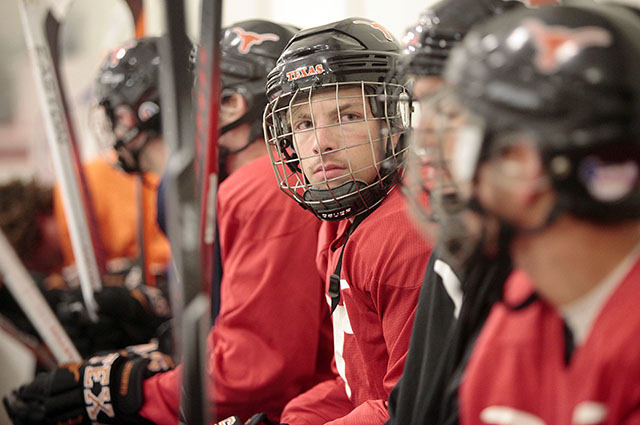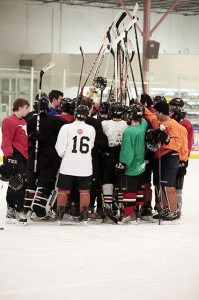In a Land of Football, UT Hockey Team Makes Its Own Way

Michael Webb, 19, is a sophomore finance major from Fort Worth and a forward on the University of Texas’ 11-year-old hockey team. Photo by Oscar Ricardo Silva.
By Will Korn
For Reporting Texas
Twice a week, 20 University of Texas students lace their skates at 6 a.m., before most of their peers have even turned on their warm showers.
The Texas Longhorns have had a club hockey team for the last 11 years. The program is different from the powerhouse programs of the north and northeast, however, with no scholarships and a small budget. The players aren’t likely to play professionally — no Longhorn has ever done so. Head coach Rick Jardine, a Penn State graduate, said managing a team like this is atypical.
“This job is pretty unique,” Jardine said. “We have to be flexible with the players’ schedules. The players on this team are devoted to education. They have chosen that over hockey. Things are different up north, where they are constantly churning out the best players.”
In a state where football has long been king, hockey arrived just 20 years ago. The Minnesota North Stars of the National Hockey League moved to Dallas in 1993 and became the Dallas Stars, who won their only Stanley Cup in 1999. Ten years later, the Texas Stars, Dallas’ American Hockey League affiliate, made its home in Cedar Park.
Keith Andresen, the Dallas Stars’ assistant vice president for hockey programs, said the sport continues to grow in the state.
“Over the last 15, 20 years, the quality of coaching has really improved in Texas,” Andresen said. “You’ll start to see more kids from Texas playing at higher levels now. The best players in the state are as good as the best players anywhere else. There are just far fewer of them around.”
The Longhorns are trying to grow their program on a much smaller scale. The 20 players on the team understand their chances are slim of playing in higher leagues. Instead, they’re more committed to their degrees, which include business, engineering and natural science.
Still, they show an unwavering loyalty to this team.
“Being committed to this team means waking up at 5:30 every Tuesday and Thursday morning for practice,” said Chet Danto, a sophomore defenseman. “It means giving your all in practice. It means showing up to every game and giving your all the entire game regardless of the situation.”
Texas plays 25 to 30 games a season, including some against Texas A&M, UTSA, North Texas, Dallas Baptist, Texas State and TCU. The Longhorns and other Texas college teams compete in Division II of the American Collegiate Hockey Association, far less competitive than NCAA Division I schools such as Michigan or Minnesota.
The Texas players realize that. They understand why they’re here.
“We know we probably aren’t at the talent level to compete in the NCAA,” said Joseph Halford, a senior business student, and a forward and club president.
A future transition to NCAA competition is unlikely, but the players say the program is on an exciting upswing.
“Last year we only had nine players,” Halford said. “We went on a pretty rigorous recruiting process and brought in 12 new freshman. Now we have a full roster of 20 guys.”
To accommodate their practice times, players are encouraged to take classes that start at 9:30 a.m. or later. The team travels on Friday afternoons and plays on Friday and Saturday nights. Travel time consumes almost the entire weekend.
“We have a good, dedicated group of guys who want to build the team to a nationally recognized ACHA program,” said Danto, the sophomore defenseman.
Texas’ home games generally draw a crowd of between 80 to 90 people at the Cedar Park Center and Chaparral Ice at Austin’s Northcross Mall. Parents, friends and the occasional fraternities are the most common spectators. In this part of the country, large crowds are uncommon at hockey games, especially for a college club team.
“We are trying to build a bigger hockey following on UT’s campus,” Halford said. “The students that came last year really got hooked on it and have been coming back again this year.”
The low turnout doesn’t bother the players. They are still playing the game they love.
“UT has always provided a fun environment for us,” Halford said. “We are mainly here just to have fun, stay in shape and win hockey games.”
